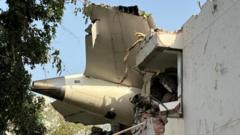Did Fuel Cut-Off Lead to Air India Crash? Preliminary Report Reveals Shocking Details

Understanding the Air India Tragedy: A Deep Dive into the Preliminary Report
The recent crash of Air India's Boeing 787-8 Dreamliner has left a profound impact on the aviation community and the families of the victims. On June 12, 2023, the aircraft tragically went down shortly after takeoff from Ahmedabad, resulting in the loss of 260 lives, with only one survivor. The preliminary investigation report released by the Aircraft Accident Investigation Bureau (AAIB) has raised critical questions about the circumstances surrounding the crash, particularly concerning the aircraft's fuel control systems and the actions of the flight crew. In this article, we will explore the details outlined in the preliminary report, the ongoing investigation, and the implications for aviation safety in India and beyond.
The Crash: A Timeline of Events
Understanding the sequence of events leading up to and during the crash is crucial for grasping the gravity of the situation. Here’s a concise timeline:
- June 12, 2023: The Air India Boeing 787-8 Dreamliner takes off from Ahmedabad.
- Seconds after takeoff: Both fuel control switches are moved to the cutoff position, causing both engines to lose thrust.
- Mayday call: One of the pilots issues a mayday call just before the aircraft crashes into a building.
- Post-crash: Investigators recover the aircraft's black boxes, providing critical data for the investigation.
The Findings of the Preliminary Report
The preliminary report by the AAIB has shed light on several key aspects of the crash. Here are the major findings:
Fuel Control Switches and Engine Thrust Loss
One of the most alarming revelations from the report is that both fuel control switches moved from the "run" position to "cutoff" within a second after takeoff. This action is typically reserved for emergencies, such as engine fires, or during landing procedures. The sudden loss of thrust from both engines led to a rapid deceleration of the aircraft.
Cockpit Communications
Recovered cockpit voice recordings revealed a moment of confusion among the pilots. One pilot questioned why the fuel had been cut off, with the other denying any responsibility for the action. This exchange indicates a potential disconnect between the crew members at a critical moment.
Engine Restart Attempts
After the fuel switches were moved back to their normal inflight position, one engine was able to regain thrust. However, this was insufficient to stabilize the aircraft, resulting in its tragic descent.
Investigation Focus and Pilot Actions
The preliminary report indicates that the ongoing investigation will focus heavily on the actions of the pilots. There is no evidence at this stage suggesting mechanical failure or external factors such as bird strikes, which had been a point of speculation.
Implications for Air India and Aviation Safety
This crash marks a significant setback for Air India, which is currently undergoing a transformation following its privatization by the Tata Group in 2022. The airline has announced a reduction in international operations while managing the repercussions of this tragic incident. Here are some implications for the airline and aviation safety:
Operational Changes
Following the crash, Air India has implemented operational changes, including:
- Reduced international flights.
- Enhanced safety checks on its fleet, particularly the 33 Dreamliners.
- Increased collaboration with aviation regulators to ensure compliance and safety standards.
Reassessing Safety Protocols
The crash has prompted a reevaluation of safety protocols within the Indian aviation sector. The Directorate General of Civil Aviation (DGCA) has stated that India’s aviation safety record has generally been better than the global average over the past decade. However, the recent incident has drawn attention to potential maintenance oversights and training deficiencies that may require urgent addressing.
The Path Forward: Ongoing Investigations
As the investigation by the AAIB continues, a more detailed report is expected within 12 months. This report will likely include recommendations for the improvement of safety measures and protocols in the aviation industry. Here are some areas that may be explored:
Mechanical and Operational Standards
Investigators may recommend a thorough review of mechanical standards for fuel control systems, particularly in light of the FAA's previous advisories regarding Boeing aircraft. Ensuring that safety features are operational and effective will be crucial in preventing future incidents.
Training and Crew Resource Management
The cockpit communications during the incident highlight the need for improved training in crew resource management. Emphasizing effective communication and decision-making under pressure could help prevent misunderstandings that lead to catastrophic outcomes.
Conclusion: A Call for Safety and Vigilance
The tragic crash of Air India’s Boeing 787-8 Dreamliner serves as a stark reminder of the complexities and challenges of air travel. While investigations continue, it is imperative for the aviation industry to prioritize safety and accountability. The families of the victims deserve answers, and the aviation community must learn from this tragedy to enhance safety measures and protocols. As we await the final report, it is essential to reflect on the importance of vigilance in aviation safety. What steps do you believe should be taken to improve safety in the aviation industry? #AviationSafety #AirIndia #FlightSafety
Frequently Asked Questions
What caused the Air India crash?
The preliminary report indicates that both fuel control switches were cut off shortly after takeoff, resulting in a loss of thrust from both engines. The investigation is ongoing to determine the exact cause and circumstances surrounding this action.
How many people were on board the Air India flight?
The Air India flight had a total of 261 individuals on board, including passengers and crew members. Tragically, 260 lost their lives in the crash.
What actions is Air India taking following the crash?
Air India has reduced its international operations and is conducting enhanced safety checks on its fleet to ensure compliance with safety standards.
What is the expected timeline for the final investigation report?
A more detailed report from the AAIB is expected within 12 months, which will provide further insights into the crash and any recommendations for safety improvements.
Published: 2025-07-12 08:41:24 | Category: technology



